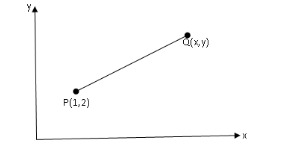
Find the terminal point of the vector \[\overrightarrow {{\text{PQ}}} \] whose initial point is \[P(1,2)\] and whose components along x-axis and y-axis are \[ - 2\] and \[3\] respectively.
Answer
553.5k+ views
Hint: We are asked to find the terminal or end point of the given vector. The x-component and y-component is given, using those from the vector. The initial point is also given use this point and the vector you formed using the given components to find the end point.
Complete step-by-step answer:
Given a vector \[\overrightarrow {{\text{PQ}}} \]
Initial point of the vector is \[P(1,2)\]
x-component of the vector is \[x = - 2\]
y-component of the vector is \[y = 3\]
Therefore, the vector \[\overrightarrow {{\text{PQ}}} \] can be written as, \[\overrightarrow {{\text{PQ}}} = - 2\widehat {\text{i}} + 3\widehat {\text{j}}\] (i)
Let the terminal point be \[Q(x,y)\]
Let us draw a diagram to understand the problem properly,

Now, observing the figure we can write the vector \[\overrightarrow {{\text{PQ}}} \] in terms of their initial and final position vectors as,
\[\overrightarrow {{\text{PQ}}} = \overrightarrow {\text{Q}} - \overrightarrow {\text{P}} \] (ii)
The initial point \[P(1,2)\] can be written in vector form as,
\[\overrightarrow {\text{P}} = 1\widehat {\text{i}} + 2\widehat {\text{j}}\] (iii)
The final point \[Q(x,y)\] can be written in vector form as,
\[\overrightarrow {\text{Q}} = x\widehat {\text{i}} + y\widehat {\text{j}}\] (iv)
Now, putting the values from equation (iii) and (iv) in equation (ii), we get
\[\overrightarrow {{\text{PQ}}} = \left( {x\widehat {\text{i}} + y\widehat {\text{j}}} \right) - \left( {1\widehat {\text{i}} + 2\widehat {\text{j}}} \right) \\
\Rightarrow \overrightarrow {{\text{PQ}}} = (x - 1)\widehat {\text{i}} + (y - 2)\widehat {\text{j}} \]
Now, putting the value of \[\overrightarrow {{\text{PQ}}} \] from equation (i), we get
\[ - 2\widehat {\text{i}} + 3\widehat {\text{j}} = (x - 1)\widehat {\text{i}} - (y - 2)\widehat {\text{j}}\]
Now, equating x-component we get,
\[- 2 = x - 1 \\
\Rightarrow x = - 1 \]
Equating y-component we get,
\[3 = y - 2 \\
\Rightarrow y = 5 \]
Therefore, the terminal point is \[Q( - 1,5)\]
So, the correct answer is “ \[Q( - 1,5)\] ”.
Note: A vector has a starting point and an ending or terminal point. The vector can be formed by subtracting the terminal position vector from the initial position vector. A vector has both magnitude and direction. Suppose we have a vector \[\overrightarrow {\text{A}} = a\widehat i + b\widehat j\] then its magnitude can be written as, \[{\text{A}} = \sqrt {{a^2} + {b^2}} \] . Always remember these basic concepts of vectors as you may have to use these in solving many problems.
Complete step-by-step answer:
Given a vector \[\overrightarrow {{\text{PQ}}} \]
Initial point of the vector is \[P(1,2)\]
x-component of the vector is \[x = - 2\]
y-component of the vector is \[y = 3\]
Therefore, the vector \[\overrightarrow {{\text{PQ}}} \] can be written as, \[\overrightarrow {{\text{PQ}}} = - 2\widehat {\text{i}} + 3\widehat {\text{j}}\] (i)
Let the terminal point be \[Q(x,y)\]
Let us draw a diagram to understand the problem properly,

Now, observing the figure we can write the vector \[\overrightarrow {{\text{PQ}}} \] in terms of their initial and final position vectors as,
\[\overrightarrow {{\text{PQ}}} = \overrightarrow {\text{Q}} - \overrightarrow {\text{P}} \] (ii)
The initial point \[P(1,2)\] can be written in vector form as,
\[\overrightarrow {\text{P}} = 1\widehat {\text{i}} + 2\widehat {\text{j}}\] (iii)
The final point \[Q(x,y)\] can be written in vector form as,
\[\overrightarrow {\text{Q}} = x\widehat {\text{i}} + y\widehat {\text{j}}\] (iv)
Now, putting the values from equation (iii) and (iv) in equation (ii), we get
\[\overrightarrow {{\text{PQ}}} = \left( {x\widehat {\text{i}} + y\widehat {\text{j}}} \right) - \left( {1\widehat {\text{i}} + 2\widehat {\text{j}}} \right) \\
\Rightarrow \overrightarrow {{\text{PQ}}} = (x - 1)\widehat {\text{i}} + (y - 2)\widehat {\text{j}} \]
Now, putting the value of \[\overrightarrow {{\text{PQ}}} \] from equation (i), we get
\[ - 2\widehat {\text{i}} + 3\widehat {\text{j}} = (x - 1)\widehat {\text{i}} - (y - 2)\widehat {\text{j}}\]
Now, equating x-component we get,
\[- 2 = x - 1 \\
\Rightarrow x = - 1 \]
Equating y-component we get,
\[3 = y - 2 \\
\Rightarrow y = 5 \]
Therefore, the terminal point is \[Q( - 1,5)\]
So, the correct answer is “ \[Q( - 1,5)\] ”.
Note: A vector has a starting point and an ending or terminal point. The vector can be formed by subtracting the terminal position vector from the initial position vector. A vector has both magnitude and direction. Suppose we have a vector \[\overrightarrow {\text{A}} = a\widehat i + b\widehat j\] then its magnitude can be written as, \[{\text{A}} = \sqrt {{a^2} + {b^2}} \] . Always remember these basic concepts of vectors as you may have to use these in solving many problems.
Recently Updated Pages
A man running at a speed 5 ms is viewed in the side class 12 physics CBSE

The number of solutions in x in 02pi for which sqrt class 12 maths CBSE

State and explain Hardy Weinbergs Principle class 12 biology CBSE

Write any two methods of preparation of phenol Give class 12 chemistry CBSE

Which of the following statements is wrong a Amnion class 12 biology CBSE

Differentiate between action potential and resting class 12 biology CBSE

Trending doubts
What are the major means of transport Explain each class 12 social science CBSE

Which are the Top 10 Largest Countries of the World?

Draw a labelled sketch of the human eye class 12 physics CBSE

Explain sex determination in humans with line diag class 12 biology CBSE

Explain sex determination in humans with the help of class 12 biology CBSE

Differentiate between homogeneous and heterogeneous class 12 chemistry CBSE




